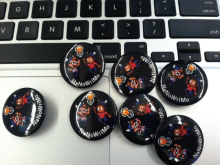NaNoWriMo: An #EduAwesome Project for Your #BestYearEver

The first time I introduced National Novel Writing Month (a.k.a. NaNoWriMo) to my 8th graders, I was terrified. One of my teacher friends had said, “They’ll run screaming from the classroom in tears!”
Some students did later confess to a brief moment of panic (“I almost lost my lunch!”), but the end result was resoundingly the most powerful and successful writing project I have ever seen in my classroom. So before you click away in fear at the words “novel writing,” let me share what NaNoWriMo is and why you should offer your students this literary challenge.
What It Is
According to the Young Writers Program, NaNoWriMo is “a fun, seat-of-your-pants writing event where the challenge is to complete an entire novel in just 30 days. For one month, you get to lock away your inner editor, let your imagination take over, and just create!” According to me, 8th grade English teacher, NaNoWriMo is the best writing project I have ever seen my students tackle, and it includes writing process, community, strategies, revision, and publishing. So how does NaNoWriMo turn students into enthusiastic writers?
Challenge
We know that challenging our students to aim high can motivate and inspire them, but who would think challenging them to write a novel in a month wouldn’t just terrify them? I don’t think my typical student dreams of writing a novel, but here’s what I discovered: given a meaningful challenge, plus resources, support and lots of time to write, students will write with enthusiasm.
Student Ownership
My students do their best writing when they own the genre, topic and final product. With NaNoWriMo, students write the stories of their choice. Often they mimic the books that they love to read: dystopian worlds, wizard fantasies, historical fiction, teen romance, zombie gore. With guidance, they choose a challenging yet attainable word goal, allowing each student to be successful while tackling a significant piece of writing. I have spent many years devising clever projects to motivate my students to write, but for the first time in my career students came to class begging, “Can we please start writing now?”
Online Support
My students join the online NaNoWriMo writing community, where they create their own author page, upload a book cover they have designed themselves, share their book’s title, genre, summary and an excerpt, connect with other young writers, compete in “word wars,” track their daily progress towards their goals, and read tips from published authors. As they encounter the inevitable writer’s block, they learn to jump to the writing community for productive distractions and genuine writing help. Bonus: the online NaNo community serves as a perfect avenue for teaching (and practicing) digital citizenship.
Publication
One of the most exciting aspects of the Young Writers Program is that students who successfully make it to their writing goal by November 30 are rewarded with the opportunity to publish their novel, receive five copies for free, and sell their novels on Amazon. (See my students’ novels on Amazon.) But there’s no need to wait until the month is over to start publishing. We publish our work in a variety of ways:
- Sharing one great line on a class bulletin board
- Posting a proud excerpt on the NaNoWriMo site
- Exchanging excerpts in a shared Google Doc
- Author’s Chair at the end of class: reading aloud from our works-in-progress
- Sharing our work with the community: our local bookstore hosts Author Nights for students who want to read aloud from their completed novels
Common Core Aligned
While “Common Core aligned” doesn’t really make my heart sing, the reality is that most of us must use curriculum that meets certain standards. Fortunately, the folks at the Young Writers Program provide detailed documentation of how NaNoWriMo does align with Common Core Standards, so if your boss, school board, community members or parents question the value of “30 days of literary abandon,” you’ve got back-up.
Confidence and Pride
I’m certain that the best way to build our students’ self-esteem is to give them opportunities to struggle, work through difficulties, and find their own voices in the process. My students validated this in their enthusiastic responses to the NaNoWriMo project. My favorite comes from Jessie, a girl who had been labeled below grade level in her reading and writing skills, and who was not successfully engaged in her own education: “I just think this whole thing about writing a novel is really cool. It made me think that a lot of things could be possible in the world. I mean I am thirteen years old and I just wrote my own dang novel! How cool is that? I think it is honestly amazing. I loved the writing time and I wish it wasn't over!”
The actual writing of the novels starts on November 1, but free curriculum provided by the Young Writers Program of NaNoWriMo makes it easy for teachers to devote weeks (even a couple months) of valuable class time to the project. Also check out my own NaNoTeacher site for help bringing this awesome writing experience to your students.
Stay tuned over the next couple months for a few more posts on the NaNoWriMo project: getting your classroom ready, getting your students ready, assessing their work, and publishing.
Update 2025: The original NaNoWriMo organization folded in early 2025, but the classroom resources for young writers are available on NaNo2.org.